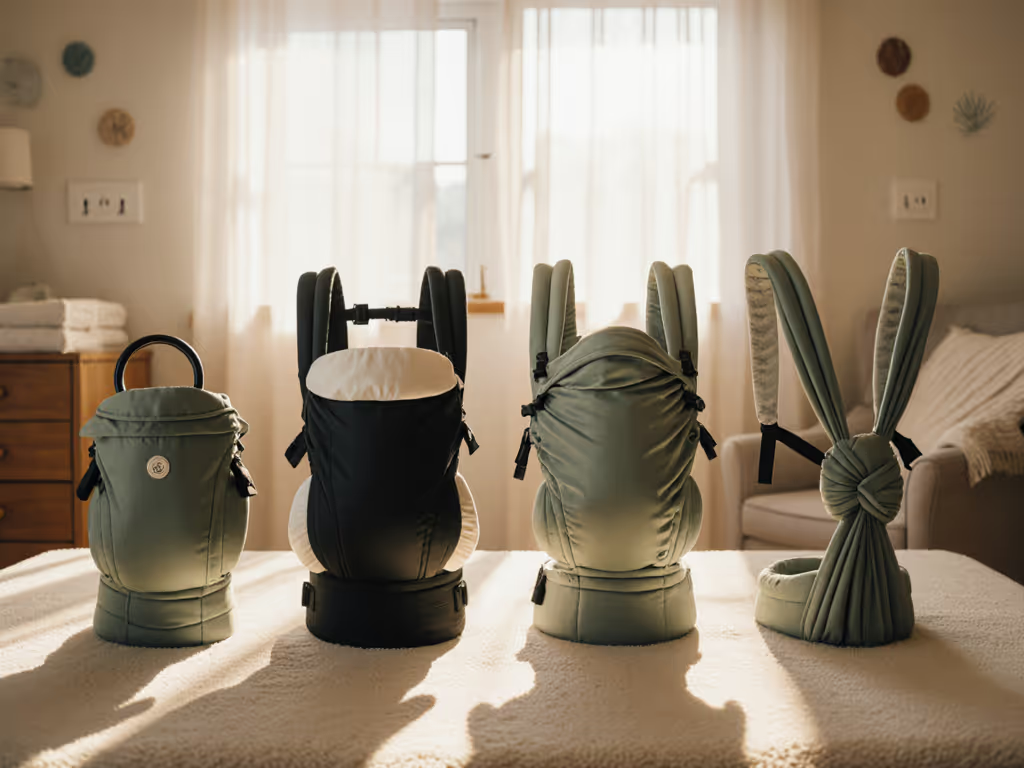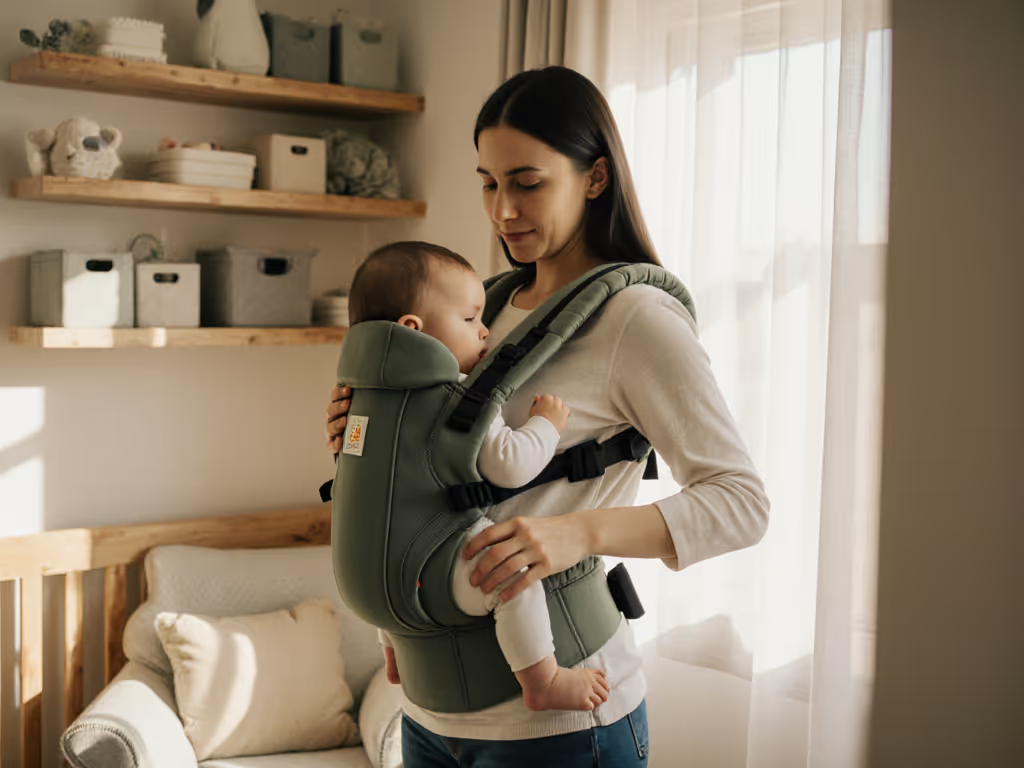
Complete Guide to Newborn Carry Options

Over 80 percent of new parents feel unsure about the safest way to carry their newborn. The first weeks with a baby are filled with questions about comfort, bonding, and proper support. Making the right choice matters because carrying techniques and carrier styles can shape both your baby’s development and your daily routine. This guide explains practical newborn carry options, highlights proven benefits, and shares expert advice that helps parents create secure, nurturing connections from day one.
Key Takeaways
| Point | Details |
|---|---|
| Importance of Babywearing | Newborn carrying fosters vital bonding, supports physical development, and enhances caregiver mobility. |
| Carrier Selection Criteria | Choosing carriers should prioritize ergonomic support, individual comfort, and infant safety, considering factors like body type and infant size. |
| Safe Positioning Guidelines | Proper positioning is crucial to prevent musculoskeletal issues, emphasizing the natural "M" shape for hips and ensuring head and neck support. |
| Monitoring and Adjustments | Continuous assessment of the carrier fit and infant comfort is essential to avoid risks, adjusting techniques as needed for safety and adaptability. |
Defining Newborn Carry Options and Benefits
Babywearing represents a profound connection between caregiver and infant that extends far beyond simple transportation. Newborn carry options are specialized techniques and tools designed to safely support an infant's physical development while promoting crucial bonding experiences. These methods enable parents and caregivers to maintain close physical contact with their newborns while maintaining mobility and hands-free functionality.
The World Health Organization (WHO) emphasizes the critical importance of close physical contact, highlighting that skin-to-skin contact provides numerous developmental advantages. According to WHO research, immediate physical proximity helps regulate the newborn's body temperature, heart rate, and stress levels. Newborn carrying techniques support these benefits by:
- Promoting consistent thermal regulation
- Supporting neurological development through sensory stimulation
- Enhancing emotional security and attachment
- Facilitating easier breastfeeding transitions
- Allowing caregivers increased mobility
Physiological benefits of newborn carrying extend beyond immediate comfort. When a baby is carried correctly, their spine, hip, and neck receive natural support that mimics the womb environment. This positioning helps prevent potential musculoskeletal issues while encouraging healthy physical development. Ergonomic carry methods distribute the infant's weight evenly, reducing strain on both the caregiver and the baby.
Ultimately, selecting the right newborn carry option requires understanding individual needs, infant size, and personal comfort. Whether using wraps, slings, structured carriers, or other methods, the core goal remains consistent: creating a safe, nurturing environment that supports both physical proximity and developmental well-being. Proper technique and informed selection are key to transforming babywearing from a simple convenience into a powerful bonding experience.
Types of Carriers Suitable for Newborns
Choosing the right newborn carrier is a critical decision that impacts both infant safety and caregiver comfort. Each carrier type offers unique features designed to support a newborn's delicate physiological needs while providing parents with practical mobility solutions. Understanding the nuanced differences between carrier styles can help caregivers make informed choices that prioritize infant health and development.
The primary carrier types suitable for newborns include:
Here's a comparison of newborn carrier types and their key features:
| Carrier Type | Main Features | Benefits |
|---|---|---|
| Wraps | Soft, long fabric<br>Highly adjustable | Maximum skin-to-skin contact<br>Thermal regulation<br>Flexible fit |
| Slings | Single-shoulder support<br>Quick to wear | Easy breastfeeding<br>Immediate infant access |
| Structured Carriers | Padded straps<br>Adjustable buckles | Built-in support<br>Even weight distribution |
| Mei Tai Carriers | Hybrid design<br>Wrap ties, structured body | Balanced support<br>Customizable fit |
- Wraps: Soft, long pieces of fabric that offer maximum flexibility and close body contact
- Slings: Single-shoulder carriers providing quick and easy positioning
- Structured Carriers: More rigid designs with built-in support and adjustable features
- Mei Tai Carriers: Traditional Asian-inspired carriers combining wrap flexibility with structured support
According to the National Institute of Child Health and Human Development (NICHD), proper carrier selection should prioritize several key ergonomic considerations. Infant positioning remains paramount, with recommendations focusing on maintaining a natural "M" shape leg position that supports hip development. Carriers should allow babies to be held in a vertical position, supporting their spine's natural curvature and preventing unnecessary strain.
Each carrier type presents distinct advantages for newborn care. Stretchy wraps, for instance, provide exceptional skin-to-skin contact and thermal regulation, mimicking the womb environment. Structured carriers offer more structured support for parents with less flexible carrying techniques. Slings provide quick accessibility for breastfeeding and immediate infant interaction. The World Health Organization's Nurturing Care Framework emphasizes that regardless of carrier type, the fundamental goal is creating a responsive, physically close environment that supports infant neurological and emotional development.
When selecting a newborn carrier, caregivers must consider factors beyond design. Individual body type, infant weight, personal comfort, and specific lifestyle needs all play crucial roles in determining the most appropriate carrying method. Regular assessment of carrier fit, ongoing learning of proper techniques, and consulting pediatric professionals can help ensure a safe, comfortable babywearing experience that supports both caregiver and infant.

Safe Positioning and Essential Support Guidelines
Newborn positioning is a critical aspect of safe carrying that directly impacts infant health and development. The World Health Organization (WHO) emphasizes that proper positioning is not just about comfort, but about preventing potential physical and physiological complications. Incorrect carrying techniques can lead to unnecessary strain on a newborn's delicate musculoskeletal system, potentially causing long-term developmental challenges.
Key principles of safe newborn positioning include:
- Maintaining a natural "M" shape hip position
- Supporting the infant's spine in its natural curved alignment
- Ensuring clear airway and breathing pathways
- Preventing excessive head and neck movement
- Distributing the infant's weight evenly
The critical support zones for newborn carrying involve protecting three primary areas: the head and neck, the spine, and the hips. Proper head support is paramount, as newborns lack the muscle strength to control their head movements independently. Carriers should provide consistent neck and head support, keeping the baby's head close enough to kiss, which ensures both safety and emotional connection.
WHO's Early Essential Newborn Care guidelines highlight that ergonomic positioning can significantly reduce risks of respiratory complications and musculoskeletal stress. A correctly positioned newborn can breathe easily, maintain body temperature, and experience reduced physiological stress. This means the carrier should allow the baby to be in a vertical position, with their chest against the caregiver's body, creating a natural "tummy to tummy" arrangement that mimics intrauterine positioning.
Beyond physical positioning, caregivers must continuously monitor their newborn's comfort and well-being. Regular checks for proper alignment, breathing ease, and infant responsiveness are crucial.
Professional guidance from pediatric specialists can provide personalized insights into individual infant needs, ensuring that each carrying method is tailored to the specific physiological characteristics of the newborn. Remember, safe positioning is an ongoing process of learning, adapting, and responding to your infant's unique developmental stages.
![]()
Comfort, Fit, and Customization Tips
Selecting the perfect newborn carrier goes far beyond aesthetic preferences, involving a complex interplay of physical compatibility, individual body mechanics, and infant needs. The National Institute of Child Health and Human Development (NICHD) emphasizes that carrier comfort directly impacts both caregiver endurance and infant safety, making personalized fit a critical consideration in babywearing practices.
Key customization strategies include:
- Adjusting carrier straps for weight distribution
- Selecting fabric types matching climate and activity levels
- Considering personal body shape and size
- Matching carrier style to specific lifestyle demands
- Accounting for potential postpartum body changes
The World Health Organization's Nurturing Care Framework highlights that carrier adaptability is essential for responsive caregiving. Carriers should offer multiple adjustment points that accommodate changing body sizes, infant growth, and varying carrying positions. Elastic or stretchy materials provide additional flexibility, allowing seamless transitions between different carrying techniques while maintaining consistent support for both caregiver and infant.
Ergonomic considerations extend beyond immediate comfort. Proper carrier fit can prevent long-term physical strain, reducing risks of back pain, shoulder tension, and musculoskeletal complications for caregivers. The ideal carrier should distribute weight evenly, create a natural center of gravity, and provide sufficient lumbar support. This means examining factors like padding thickness, strap width, and waistband design to ensure maximum comfort during extended wearing periods.
Ultimately, finding the perfect carrier is a personalized journey of trial, adjustment, and attentive listening to both your body and your infant's responses. Regular professional fittings, willingness to experiment with different styles, and maintaining open communication with healthcare providers can transform babywearing from a potential challenge into a deeply intuitive and comfortable experience. Remember that comfort is dynamic - what works today might need modification as your baby grows and your own body changes.
Common Mistakes and Safety Risks to Avoid
Newborn carrier safety demands meticulous attention to detail, as seemingly minor mistakes can lead to significant risks for vulnerable infants. The National Institute of Child Health and Human Development (NICHD) emphasizes that many carrier-related accidents stem from preventable user errors, highlighting the critical importance of comprehensive understanding and consistent vigilance during babywearing practices.
Most frequent safety mistakes include:
- Incorrect positioning of the infant's spine and hips
- Inadequate head and neck support
- Loose or improperly adjusted carrier straps
- Obstructed breathing pathways
- Carrying newborns in inappropriate carrier types
- Failing to monitor infant's temperature and comfort
- Wearing carriers during high-risk activities
The World Health Organization's Early Essential Newborn Care guidelines specifically warn about potential complications arising from improper carrier techniques. Newborns have limited ability to communicate discomfort, making it crucial for caregivers to proactively assess and adjust carrying methods. Risks can include respiratory challenges, excessive heat retention, compromised circulation, and potential musculoskeletal stress that might impact long-term developmental outcomes.
Critical safety considerations extend beyond immediate physical positioning. Caregivers must remain continuously aware of their infant's physiological responses, watching for signs of distress such as changes in breathing patterns, skin color, or body temperature. Professional recommendations suggest frequent carrier adjustments, avoiding prolonged carrying during extreme temperatures, and maintaining clear visual and respiratory access. Regular consultation with pediatric professionals, practicing carrier techniques in safe environments, and maintaining an adaptive, observant approach can significantly mitigate potential risks associated with newborn carrying.
Ultimately, safe babywearing requires a combination of education, practice, and intuitive responsiveness. No single technique works universally, and what feels comfortable for one caregiver-infant pair might pose risks for another. Continuous learning, willingness to seek professional guidance, and maintaining a vigilant, adaptive mindset are the most powerful tools in ensuring a safe, nurturing babywearing experience.
Discover Safe and Comfortable Newborn Carrying Solutions Today
Choosing the right newborn carry option can feel overwhelming when considering safety, comfort, and developmental support. This guide highlights crucial concerns like proper infant positioning, head and neck support, and carrier fit — common challenges that every caregiver faces. If you want to protect your newborn’s health while enjoying the closeness and freedom babywearing provides, finding trustworthy and practical guidance is essential.
At Caregiver Carry, you will find expert-backed information tailored specifically for new parents and experienced caregivers alike. Our detailed safety checklists, ergonomic comparisons of wraps, slings, and structured carriers, plus step-by-step tutorials make it easier to choose and use carriers designed for your unique body and lifestyle. Start exploring our complete guides today to feel confident in your babywearing journey. Don’t wait—your baby’s safety and your comfort depend on making the right choice now.
Frequently Asked Questions
What are the benefits of using newborn carriers?
Newborn carriers provide essential support for an infant's physical development while promoting bonding. They help regulate body temperature, support neurological growth, enhance emotional security, and allow for easier breastfeeding transitions.
How do I choose the right carrier type for my newborn?
Choosing the right carrier depends on individual needs, infant size, and caregiver comfort. Consider factors such as ergonomic support, ease of use, and how well the carrier fits your body type and lifestyle.
What are the key safety considerations when using a newborn carrier?
Key safety considerations include ensuring proper positioning that supports the infant's spine and hips, providing adequate head and neck support, monitoring for obstructed breathing, and regularly checking the baby's comfort and temperature.
How can I adjust my newborn carrier for maximum comfort?
To maximize comfort, adjust the carrier straps for even weight distribution, choose appropriate fabric types for climate, and consider your body shape. Regular assessments and adjustments may also be necessary as your baby grows and your body changes.



